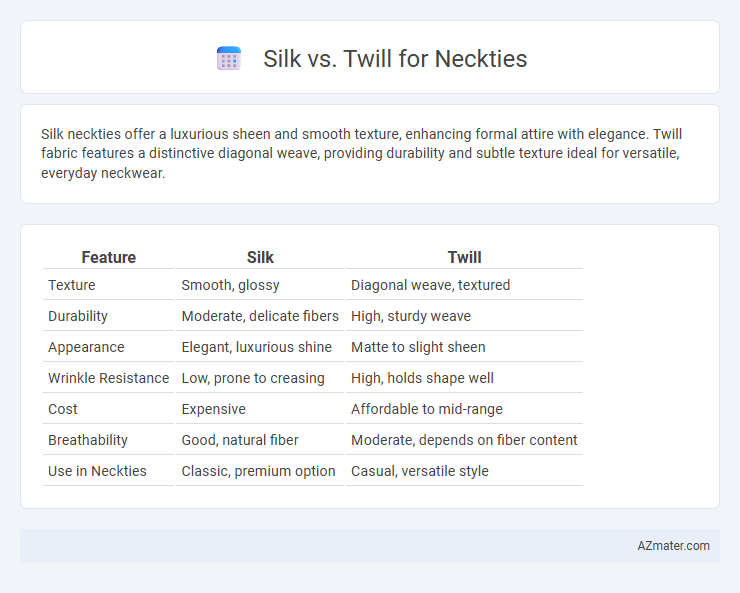Silk neckties offer a luxurious sheen and smooth texture, enhancing formal attire with elegance. Twill fabric features a distinctive diagonal weave, providing durability and subtle texture ideal for versatile, everyday neckwear.
Table of Comparison
| Feature | Silk | Twill |
|---|---|---|
| Texture | Smooth, glossy | Diagonal weave, textured |
| Durability | Moderate, delicate fibers | High, sturdy weave |
| Appearance | Elegant, luxurious shine | Matte to slight sheen |
| Wrinkle Resistance | Low, prone to creasing | High, holds shape well |
| Cost | Expensive | Affordable to mid-range |
| Breathability | Good, natural fiber | Moderate, depends on fiber content |
| Use in Neckties | Classic, premium option | Casual, versatile style |
Understanding Silk and Twill: Fundamental Differences
Silk fabric, derived from natural protein fibers produced by silkworms, is renowned for its smooth texture, natural sheen, and lightweight feel, making it a premium choice for neckties. Twill refers to a weaving pattern characterized by diagonal ribbing, which can be applied to various fibers, including silk, enhancing durability and adding subtle texture to ties. Understanding that silk defines the material's origin and softness while twill describes the fabric's structural weave helps distinguish the luxurious smoothness of pure silk ties from the textured finish and resilience found in silk twill neckties.
The Weaving Process: How Silk and Twill Are Made
Silk for neckties is crafted by weaving natural silk fibers harvested from silkworm cocoons, creating a smooth and lustrous fabric characterized by its fine, delicate threads. Twill, on the other hand, is a weaving technique identified by a distinctive diagonal rib pattern achieved by passing the weft thread over one or more warp threads and then under two or more warp threads, which enhances durability and texture. The intricate weaving process of silk emphasizes elegance and sheen, whereas twill's structure provides a robust and textured finish, influencing the overall look and feel of neckties.
Appearance and Texture: Visual and Tactile Contrasts
Silk neckties showcase a natural sheen and smooth, luxurious texture that enhances their elegant appearance, making them ideal for formal occasions. Twill fabric, characterized by its distinct diagonal weave, offers a subtle texture with a matte finish that provides a more structured and less reflective look. The tactile contrast between silk's soft, slippery feel and twill's slightly coarse, durable surface significantly influences the choice of tie based on desired style and comfort.
Durability and Longevity: Which Necktie Lasts Longer?
Silk neckties, prized for their luxurious sheen and smooth texture, offer moderate durability but require careful handling to avoid snags and stains, impacting their longevity. Twill neckties, characterized by a diagonal weave, provide enhanced durability and resistance to wear due to their tighter weave structure, making them more resilient for daily use. When longevity is a priority, twill neckties generally outlast silk ties owing to their robust fabric construction and stain-resistant properties.
Comfort and Wearability: How Each Feels on the Neck
Silk neckties offer a smooth, lightweight texture that feels soft and luxurious against the skin, providing exceptional comfort for all-day wear. Twill neckties, with their denser weave and slightly textured surface, deliver a sturdier feel that can be less slippery and more breathable, making them suitable for extended use. Both fabrics balance comfort and wearability, but silk's natural sheen and suppleness often make it the preferred choice for sensitive necks.
Tie Knotting: Silk vs Twill Performance
Silk neckties offer a smooth, lustrous texture that allows tie knots to form tightly and maintain sharp, clean edges, enhancing the overall knot definition. Twill neckties feature a diagonal weave that provides more grip, which helps knots hold their shape firmly without slipping throughout the day. Silk ties excel in sleekness and delicate knot detail, while twill ties prioritize stability and durability in knot performance.
Color Retention and Pattern Versatility
Silk neckties excel in color retention due to their natural protein fibers, maintaining vivid hues and rich sheens even after repeated wear. Twill weaves, characterized by diagonal rib patterns, offer enhanced pattern versatility that allows intricate designs and textures to stand out effectively on neckties. Choosing silk twill fabric combines superior colorfastness with diverse pattern options, making it ideal for long-lasting, stylish neckwear.
Occasion Suitability: Formal vs Casual Use
Silk neckties are ideal for formal occasions due to their lustrous sheen and smooth texture, which complement business suits and evening wear, enhancing sophistication. Twill neckties, with their durable weave and subtle diagonal pattern, suit casual or semi-formal settings, providing a relaxed yet polished look perfect for office or smart-casual events. Choosing between silk and twill depends on the event's dress code and desired style, where silk elevates formal attire and twill offers versatile everyday wear.
Maintenance and Cleaning Requirements
Silk neckties require delicate handling and often need professional dry cleaning to maintain their luster and prevent damage to the fibers. Twill neckties, especially those made from cotton or polyester blends, are generally more durable and can sometimes be spot cleaned or gently hand washed without losing shape. Proper storage, such as hanging or rolling, is essential for both fabrics to avoid wrinkles and preserve the tie's structure over time.
Choosing the Right Fabric: Silk vs Twill for Your Style
Silk neckties offer a smooth, luxurious finish with natural sheen, making them ideal for formal and elegant occasions, while twill ties provide a textured weave that adds subtle depth and durability suitable for both casual and professional settings. Choosing between silk and twill depends on your desired aesthetic and the event's dress code, as silk emphasizes sophistication and twill delivers versatile resilience. Consider fabric weight, pattern clarity, and how the tie complements your wardrobe to ensure a polished, cohesive look.

Infographic: Silk vs Twill for Necktie
 azmater.com
azmater.com